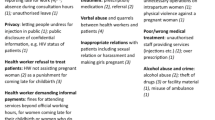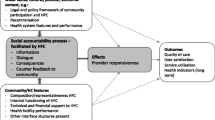Abstract
This study examined the impact of on-site and off-site technical assistance (TA) dosage on the functioning of Communities That Care prevention boards in Pennsylvania. Data on board functioning were collected over three years from board member and TA providers. Results of path models indicated little overall impact of TA dosage on board functioning the subsequent year. However, on-site TA dosage did appear to influence board functioning for younger boards and for boards who were relatively better functioning. In addition, the stability of board functioning and off-site TA was moderate to strong, the stability of on-site TA dosage was low, and poor functioning sites did not receive more TA in the following year. Editors’ Strategic Implications: This paper is one of the first quantitative examinations of the impact of TA on community-based prevention or health promotion coalitions. The authors provide a number of implications for further study with respect to TA. Thus, it should be valuable to researchers and practitioners involved in the development and implementation of such community-based efforts.

Similar content being viewed by others
References
Arbuckle, J. L. (1999). AMOS 4.01. Chicago: Smallwaters Corp.
Arthur, M. W., Hawkins, D. J., Catalano, R. F., & Olson, J. J. (1998). Diffusion project: Fall 1998 community key informant interview. Seattle, WA: University of Washington, Social Development Research Group.
Backer, T. E. (2003). Evaluating community collaborations (Vol. 158). New York: Springer.
Bierman, K. L., Nix, R. L., Maples, J. J., Murphy, S. A., & Conduct Problems Prevention Research Group. (2006). Examining the use of clinical judgment in the context of an adaptive intervention design: The Fast Track prevention program. Journal of Consulting and Clinical Psychology, 74(3), 468–481.
Bronfenbrenner, U. (1986). Ecology of the family as a context for human development: Research perspectives. Developmental Psychology, 22, 723–742.
Chatfield, C. (2004). The analysis of time series: An introduction. Boca Raton, FL: Chapman and Hall.
Chavis, D. M. (1995). Building community capacity to prevent violence through coalitions and partnerships. Journal of Health Care for the Poor and Underserved, 6, 234–245.
Chinman, M. J., Imm, P., & Wandersman, A. (2004). Getting to Outcomes 2004: Promoting accountability through methods and tools for planning, implementation, and evaluation. Santa Monica, CA: RAND Corporation.
Collins, L. M., Murphy, S. A., & Bierman, K. L. (2004). A conceptual framework for adaptive preventive interventions. Prevention Science, 5, 185196.
COMMIT Research Project. (1995). Community intervention trial for smoking cessation (COMMIT): Cohort results from a four-year community intervention. American Journal of Public Health, 85, 183–192.
Crowley, K. M., Yu, P., & Kaftarian, S. J. (2000). Prevention actions and activities make a difference: A structural equation model of coalition building. Evaluation and Program Planning, 23, 381–388.
Davis, K. D. (1998). Lessons from the field: The colorado healthy communities initiative. Denver: The Colorado Trust.
Durlak, J. A. (1998). Why program implementation is important. Journal of Prevention and Intervention in the Community, 17(2), 5–18.
Eng, E., & Parker, E. A. (1994). Measuring community competence in the Mississippi Delta: The interface between program evaluation and empowerment. Health Education Quarterly, 21, 199–220.
Feinberg, M. E., Gomez, B., Puddy, R., & Greenberg, M. (2008). Evaluation and community prevention: Validation of an integrated web-based/technical assistance model. Health, Education, and Behavior, 35, 9–21.
Feinberg, M. E., Greenberg, M. T., & Osgood, D. W. (2004). Readiness, functioning, and perceived effectiveness of community prevention coalitions: A study of Communities That Care. American Journal of Community Psychology, 33, 163–176.
Feinberg, M. E., Greenberg, M. T., Osgood, D. W., Anderson, A., & Babinski, L. (2002). The effects of training community leaders in prevention science: Communities That Care in Pennsylvania. Evaluation and Program Planning, 25, 245–259.
Feinberg, M. E., Greenberg, M. T., Osgood, W. O., & Sartorius, J. S. (2005). Can community coalitions have a population level impact on adolescent behavior problems? Communities that Care in Pennsylvania. Journal of Adolescent Health, 40, 506–513.
Florin, P., Mitchell, R., & Stevenson, J. (1993). Identifying training and technical assistance needs in community coalitions: A developmental approach. Health Education Research, 8, 417–432.
Florin, P., Mitchell, R., Stevenson, J., & Klein, I. (2000). Predicting intermediate outcomes for prevention coalitions: A developmental perspective. Evaluation and Program Planning, 23, 341–346.
Goodman, R. M., Steckler, A., Hoover, S., & Schwartz, R. (1993). A critique of contemporary community health promotion approaches: Based on a qualitative review of six programs in Maine. American Journal of Health Promotion, 7, 208–220.
Greenberg, M. T., Domitrovich, C., & Graczyk, P. A. (2000). The study of implementation in school-based prevention research: Theory, research, and practice. Washington DC: Substance Abuse and Mental Health Services Administration.
Hallfors, D., Hyunsan, C., Livert, D., & Kadushin, C. (2002). Fighting back against substance abuse: Are community coalitions winning? American Journal of Preventive Medicine, 23, 237–245.
Hawkins, J. D., & Catalano, R. F. Jr. (1992). Communities that care: Action for drug abuse prevention. San Francisco, CA: Jossey-Bass.
Hawkins, J. D., Catalano, R. F., & Arthur, M. W. (2002). Promoting science-based prevention in communities. Addictive Behaviors. Special Issue: Integration substance abuse treatment and prevention in the community, 27, 951–976.
Kegler, M. C., Steckler, A., Malek, S. H., & McLeroy, K. (1998a). A multiple case study of implementation in 10 local Project ASSIST coalitions in North Carolina. Health Education Research, 13, 225–238.
Kegler, M. C., Steckler, A., McLeroy, K., & Malek, S. H. (1998b). Factors that contribute to effective community health promotion coalitions: A study of 10 Project ASSIST Coalitions in North Carolina. Health Education and Behavior, 25, 338–353.
Kelly, J. A., Somlai, A. M., DiFranceisco, W. J., Otto-Salaj, L. L., McAuliffe, T. L., Hackl, K. L., et al. (2000). Bridging the gap between the science and service of HIV prevention: Transferring effective research-based HIV Prevention interventions to community AIDS service providers. American Journal of Public Health, 90, 1082–1088.
Klerman, L. V., Santelli, J. S., & Klein, J. D. (2005). So what have we learned? The Editors’ comments on the coalition approach to teen pregnancy. Journal of Adolescent Health, 37, S115–S118.
Kreuter, M. W., Lezin, N. A., & Young, L. A. (2000). Evaluating community-based collaborative mechanisms: Implications for practitioners. Health Promotion Practice, 1, 49–63.
Leviton, L. C., Herrera, C., Pepper, S. K., Fishman, N., & Racine, D. P. (2006). Faith in action: Capacity and sustainability of volunteer organizations. Evaluation and Program Planning, 29, 201–207.
Livit, M., & Wandersman, A. (2004). Organizational functioning: Facilitating effective interventions and increasing the odds of program success. In D. M. F. A. Wandersman (Eds.), Empowerment evaluation principals in practice (pp. 123–142). New York: Guilford.
Mitchell, R. E., Florin, P., & Stevenson, J. F. (2003). Supporting community-based prevention and health promotion initiatives: Develo** effective technical assistance systems. Health Education & Behavior, 29, 620–639.
Mitchell, R. E., Stone-Wiggins, B., Stevenson, J. F., & Florin, P. (2004). Cultivating capacity: Outcomes of a statewide support system for prevention coalitions. Journal of Prevention and Intervention in the Community, 27, 67–87.
Mittelmark, M. B., Luepker, R. V., Jacobs, D. R. J., Bracht, N., Carlaw, R. W., Crow, R. S., et al. (1986). Commmunity-wide prevention of cardiovascular disease: Education strategies for the Minnesota heart health program. Preventive Medicine, 15, 1–17.
O’Donnell, L., Scattergood, P., Alder, M., & San Doval, A. (2000). The role of technical assistance in the replication of effective HIV interventions. AIDS Education and Prevention, 12(Suppl. A), 99–111.
Oetting, E. R., Donnermeyer, J. F., Plested, B. A., Edwards, R. W., Kelly, K., & Beauvais, F. (1995). Assessing community readiness for prevention. The International Journal of the Addictions, 30, 659–683.
Patterson, G. R., & Forgatch, M. S. (1985). Therapist behavior as a determinant for client noncompliance: A paradox for the behavior modifier. Journal of Consulting & Clinical Psychology, 53(6), 846–851.
Puska, P., Salonen, J. T., Tuomilehto, J., Nissinen, A., & Kottke, T. E. (1983). Evaluating community-based preventive cardiovascular programs: Problems and experiences from the North Karelia Project. Journal of Community Health, 9, 49–64.
Reifler, B. V., Cox, N. J., Jones, B. N., Rushling, J., & Yates, K. (1999). Service use and financial performance in a replication program on adult day centers. American Journal of Geriatric Psychiatry, 7, 98–107.
Roberts, R. N., & Wasik, B. H. (1996). Evaluating the 1992 and 1993 Community Integrated Service System Projects. New Directions for Evaluation, 69, 35–49.
Roussos, S. T., & Fawcett, S. B. (2000). A review of collaborative partnerships as a strategy for improving community health. Annual Review of Public Health, 21, 369–402.
Saxe, L., Reber, E., Hallfors, D., Kadushin, C., Jones, D., Rindskopf, D., et al. (1997). Think globally, act locally: Assessing the impact of community-based substance abuse prevention. Evaluation and Program Planning, 20, 357–366.
Spoth, R. L., Greenberg, M., Bierman, K., & Redmond, C. (2004). PROSPER community-university partnership model for public education systems: Capacity-building for evidence-based, competence-building prevention. Prevention Science, 5, 31–39.
Spoth, R. L., Redmond, C., Shin, C., Greenberg, M. T., Clair, S., & Feinberg, M. E. (2007). Substance use outcomes at 18 months past baseline: The PROSPER community-university partnership trial. American Journal of Preventive Medicine, 32, 395–402.
Stevenson, J., & Mitchell, R. (2003). Community level collaboration for substance abuse prevention. American Journal of Community Psychology, 23, 371–404.
van Houten, T., Hailman, S., Yanssaneh, C. R., & Bowen, V. (1996). Transferring prevention skills to teams in public housing communities. Journal of Primary Prevention, 16, 273–301.
Wandersman, A., & Florin, P. (2003). Community interventions and effective prevention. American Psychologist. Special Issue: Prevention that works for children and youth, 58, 441–448.
Wandersman, A., Florin, P., Friedmann, R., & Meier, R. (1987). Who participates, who does not, and why? An analysis of voluntary neighborhood organizations in the United States and Israel. Sociological Forum, 2, 534–555.
Yin, R. K., Gwaltney, M. K., Hare, M., & Butler, M. O. (1999). Final report: Evaluation of the CDC-supported technical assistance network for community planning. Bethesda, MD: COSMOS Corporation.
Acknowledgments
This research is supported by a grant from the Pennsylvania Commission for Crime and Delinquency (PCCD). However, findings and recommendations herein are those of the authors and not official statements of PCCD. We want to acknowledge the enthusiastic support of Michael Pennington, Ruth Williams, Douglas Hoffman, Raymond Moneta, and Clay R. Yeager at PCCD in supporting the vision of this project. We also thank John Graham for consultation on analytic procedures. Finally we are grateful for the cooperation extended by the state-funded CTC technical assistance providers and the many CTC board members in Pennsylvania.
Author information
Authors and Affiliations
Corresponding author
Rights and permissions
About this article
Cite this article
Feinberg, M.E., Ridenour, T.A. & Greenberg, M.T. The Longitudinal Effect of Technical Assistance Dosage on the Functioning of Communities That Care Prevention Boards in Pennsylvania. J Primary Prevent 29, 145–165 (2008). https://doi.org/10.1007/s10935-008-0130-3
Received:
Accepted:
Published:
Issue Date:
DOI: https://doi.org/10.1007/s10935-008-0130-3




